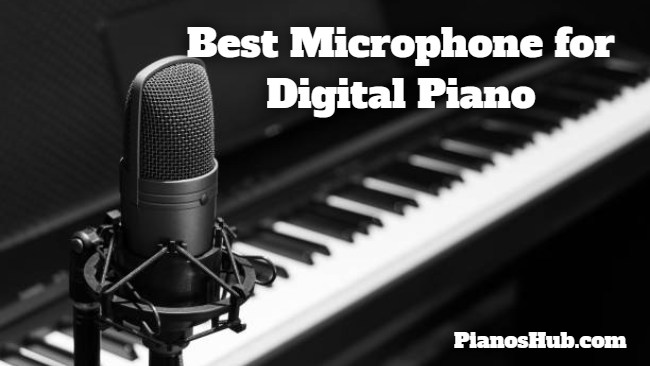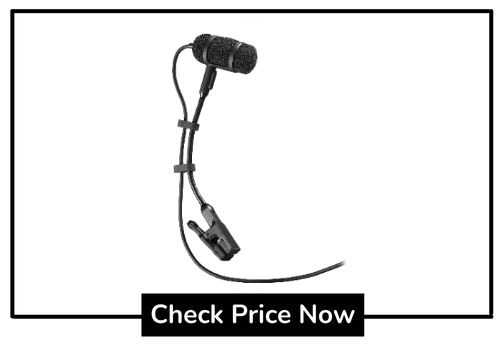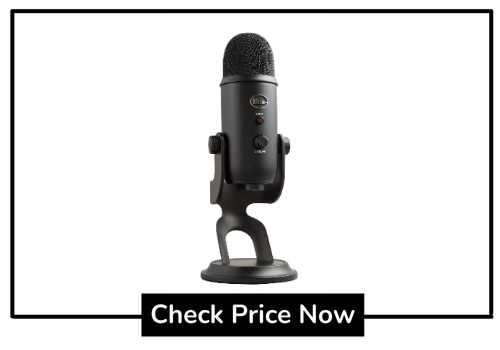When it comes to recording music, the quality of the sound is a top priority. Whether you’re a professional musician or an amateur, the right microphone is essential to capturing the best sound possible.
For musicians who play digital pianos, a good microphone is especially important. Many digital pianos also include built-in speakers so you can play along to your favorite songs. If you want to record songs or practice, a good digital piano microphone is essential.
It’s necessary to capture the full range of the instrument’s sound, so it’s necessary to have a microphone that’s capable of producing a clean, pristine signal. But with the multitude of microphones on the market, how do you know which one is the best microphone for digital piano?

This blog post will explore the three best microphone for digital pianos. We’ll discuss their features and benefits, as well as why they’re the best options for capturing your instrument’s sound. We’ll also explain why having the right microphone is so important for digital piano players.
We test microphones for digital pianos, including frequency response, frequency response uniformity, noise floor, and noise floor uniformity. The best microphone for digital piano, according to our tests, is reviewed below.
Best Microphone for Digital Piano
Our picks for the best microphone for digital piano are based on our extensive testing as well as popular customer reviews. That said, these are our picks for the best microphone for digital pianos.
Capturing the perfect sound is a difficult task, but with the right microphone, it’s possible. A good microphone will help you create a high-quality recording that sounds professional and is true to the sound of your digital piano. Whether you’re recording a solo project or a full band, having the right microphone is essential.
In this post, we’ll discuss the three best microphone for digital pianos, their features, and why they’re the best choice for capturing the full range of your instrument’s sound. We’ll also discuss why it’s important to have the right microphone and how it can help you create a higher-quality recording.
So, if you’re looking for the perfect microphone for your digital piano, read on to learn more about the three best options.
Shure SM7B Vocal Dynamic Microphone for Broadcast, Podcast & Recording
The Shure SM7B Vocal Dynamic Microphone is a microphone that can be used for a variety of purposes. It is capable of recording high-quality audio. It is equipped with 3 level controls, a presence boost, and a switch plate. The SM7B has 3 pattern options, a 60dB of gain, and a cardioid pattern. The microphone is capable of capturing audio that is warm and smooth.
It has a frequency response of 30Hz to 18kHz. It has a handlebar shock mount and a detachable windscreen which reduces any undesired noise. It is designed to be used for vocals, but it can also be used for instruments such as drums, guitar, and bass. The SM7B is a great choice for recording podcasts, voiceovers, and home studio recordings.
The Shure SM7B is a legendary vocal mic, with a smooth, articulate sound that has made it a favorite of broadcasters, podcasters, and singers for decades. The SM7B’s cardioid polar pattern rejects off-axis sounds, and its ultra-durable construction and detachable foam windscreen make it a good choice for field recording, too.
This updated model adds bass roll-off and presence boost controls and provides a graphic display of the C12 response curve. It’s still one of the best microphone for digital pianos, and it’s useful whether you’re recording at home, in a studio, or in the field.
Audio-Technica PRO 35 Cardioid Condenser Clip-on Instrument Microphone
The Audio-Technica PRO 35 Cardioid Condenser Clip-on Instrument Microphone has an extended frequency response, and it is capable of capturing subtle nuances of the performance. It is equipped with a UniMount clip, and it permits accurate positioning.
The Cardioid polar pattern reduces the pickup of sounds from the sides and rear, improving the isolation of the desired sound source. The PRO 35 has a 6′ (1.8 m) cable that is permanently attached to a microphone. It also comes with a windscreen that helps to minimize wind noise and plosives.
The Audio-Technica PRO 35 Cardioid Microphone is a high-quality condenser microphone that is designed for musicians, DJs, and presenters. It is suitable for instrument and vocal use and has interchangeable cardioid, omnidirectional, and figure-of-eight pickup patterns.
The microphone is designed to perform reliably under pressure, and it is ideal for a wide range of applications including vocals, acoustic and amplified instruments, drums, and more. The PRO 35 Cardioid Microphone is the perfect solution for mobile musicians, DJs, and presenters who need a high-quality condenser microphone on a tight budget.
Blue Yeti USB Microphone for Gaming, Recording, Streaming, Podcasting, Studio
The Blue Yeti USB Microphone is a solid choice for PC or Mac streaming and broadcasting, delivering professional-quality sound, accurate reproduction, and a suite of useful recording and streaming tools. It’s easy to use and provides good connectivity. It is capable of plugging directly into your computer, or you can connect it to a mic stand or boom arm for a solid recording experience.
The Blue Yeti USB Microphone allows you to record clear voices that are broadcast quality. It is capable of recording vocals, instruments, and podcasts. This microphone comes with a flexible cardioid, omnidirectional, bidirectional, and stereo pickup pattern. It also comes with onboard audio controls.
These controls allow you to adjust the volume of the computer microphone, select the pattern, mute the mic, and set mic gain. The microphone is also designed with a 360-degree pivot design that allows you to easily position it. Its cardioid pickup pattern delivers great vocal pickup and isolation, and it comes with four pickup patterns for instruments, podcasts, and more.
Our only major complaint is that the Blue Yeti USB Microphone is a bit pricey. Still, if you’re looking for a streaming and broadcasting mic, the Blue Yeti USB Microphone delivers quality sound, solid performance, and value for the money.
FAQs Answered about Best Microphone for Digital Piano
The following are some of the most frequently asked questions related to the best microphone for digital piano that we have answered for you.
What is a microphone for digital piano?
A microphone for a digital piano is a device that allows the user to amplify sound from the digital piano. It is typically used to increase the volume of the digital piano or to record the audio of the instrument.
What is the difference between a weighted and an unweighted keyboard?
The main difference between a weighted and unweighted keyboard is the feel when playing. A weighted keyboard is typically heavier and provides a more realistic and expressive playing experience, while an unweighted keyboard is lighter and more responsive. Weighted keyboards also produce a louder sound when playing, while unweighted keyboards are quieter.
What type of power supply do digital pianos use?
Most digital pianos use an AC power supply, either from a wall outlet or from a battery pack. Some also have a DC power supply, which can be used to power the instrument when a wall outlet is not available.
What are the benefits of using a sustain pedal with a digital piano?
The main benefit of using a sustained pedal with a digital piano is to add a richer, more expressive sound to the instrument. It allows the user to sustain notes and chords for a longer period of time, giving the music a more dynamic feel. It can also be used to add effects such as vibrato and portamento.
How do I connect a digital piano to a computer?
Most digital pianos can be connected to a computer using either a USB cable or a MIDI cable. The USB cable is used to connect the digital piano directly to a computer, while the MIDI cable is used to connect the digital piano to a MIDI interface, which can then be connected to the computer.
Conclusion
We hope this article has helped you gain a better understanding of digital piano microphones and their various features. From understanding what a microphone for a digital piano is to learning how to connect a digital piano to a computer, we hope you now have a better grasp of the topic. If you have any more queries related to the best microphone for digital pianos, feel free to reach out to our Pianos Hub team. We will be happy to help.


